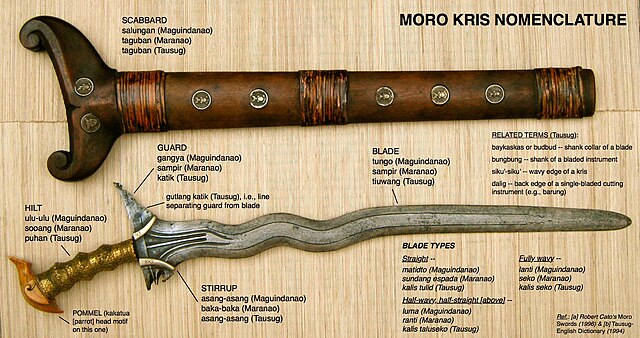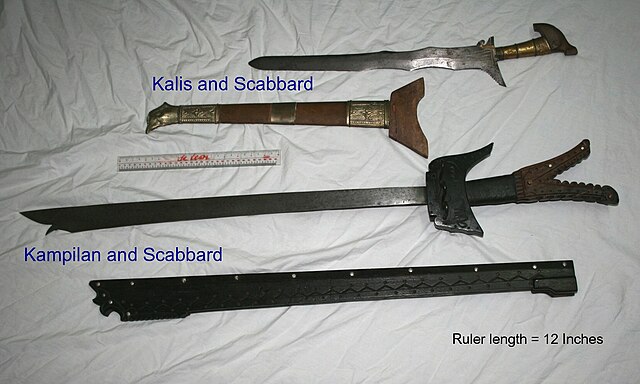A kalis is a type of Philippine sword. The kalis has a double-edged blade, which is commonly straight from the tip but wavy near the handle. Kalis exists in several variants, either with a fully straight or fully wavy blade. It is similar to the Javanese keris, but differs in that the kalis is a sword, not a dagger. It is much larger than the keris and has a straight or slightly curved hilt, making it a primarily heavy slashing weapon.
Moro kalis nomenclature, given in Tausūg, Maranao, and Maguindanao
In this example, the blade's lamination pattern and the darker high-carbon cutting edge of the blade are visible. This harder high-carbon cutting edge is termed as "sinubo" (roughly, "sandwiched").
The demarcation line indicating the separate gangya (guard) can be seen.
Two Filipino swords, a kampilan (longer) and a kalis (shorter), photographed side by side to demonstrate their size relative to each other.
The kris or keris is a Javanese asymmetrical dagger with a distinctive blade-patterning achieved through alternating laminations of iron and nickelous iron (pamor). The kris is famous for its distinctive wavy blade, although many have straight blades as well, and is one of the weapons commonly used in the pencak silat martial art native to Indonesia. Kris have been produced in many regions of Indonesia for centuries, but nowhere—although the island of Bali comes close—is the kris so embedded in a mutually-connected whole of ritual prescriptions and acts, ceremonies, mythical backgrounds and epic poetry as in Central Java. Within Indonesia the kris is commonly associated with Javanese culture, although other ethnicities in it and surrounding regions are familiar with the weapon as part of their cultures, such as the Balinese, Sundanese, Malay, Madurese, Banjar, Buginese, and Makassar people. The kris itself is considered as a cultural symbol of Indonesia and also neighbouring countries like Brunei, Malaysia, Philippines, Singapore, and Thailand.

The kris consists of three parts; blade (wilah), hilt (hulu) and sheath (warangka)
Kris as a Masterpiece of the Oral and Intangible Heritage of Humanity
Kris depicted on 9th century Borobudur bas-relief.
Kris blacksmith's workshop depicted in 15th century Candi Sukuh.








